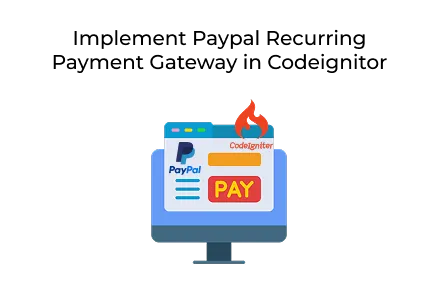Home - Scripts - Website Development

Businesses using recurring payment systems experienced a 35% increase in revenue and 40% higher customer retention within six months of implementation.
Key Points
Online payments have become a vital part of modern custom web development, especially for businesses engaged in E-commerce website projects. Recurring billing is especially crucial for subscription services like SaaS platforms, digital memberships, or online learning portals. Instead of asking users to pay manually each month, recurring payments automatically withdraw the specified amount, ensuring smooth transactions and enhancing customer experience.
This article explains PayPal integration for recurring payments in CodeIgniter development, utilizing the PayPal PHP SDK, MVC structure, and webhooks — with complete code examples.
Recurring payments, also called subscription payments, are automatic transactions in which a customer authorizes a business to withdraw funds on a regular schedule (weekly, monthly, or yearly).
Examples include:
Businesses looking to develop a subscription management system can trust PayPal integration for reliable and secure automated billing.
When handling subscriptions, you need real-time updates from PayPal:
This is where webhooks come into play. A webhook is a server-side listener that receives event notifications directly from PayPal. With webhooks, you can automatically update your database, making your payment gateway integration seamless and efficient.
CodeIgniter follows the MVC (Model-View-Controller) pattern, which is a fundamental principle in professional custom web development.
This approach keeps your project clean and organized, making it easier for teams to hire PHP developer talent to maintain or expand the project later.
Create a PayPal Developer Account
Install PayPal PHP SDK
composer require paypal/rest-api-sdk-php
Configure PayPal Credentials in .env
This configuration file holds your credentials and determines whether you’re working in sandbox or live mode. Keeping credentials separate ensures flexibility when moving from testing to production.
The view is where customers interact with the PayPal subscription button. Here, we include PayPal’s JavaScript SDK, specify the plan ID, and handle responses like approval, cancellation, and errors.
This is a key part of e-commerce website development, as it ensures a smooth user experience.
app/Views/subscription/index.php
The controller processes actions after the user interacts with PayPal. It handles success, cancellation, and completion routes. You can also expand it to connect with your database model to update subscription statuses.
This forms the backbone of your subscription management system, ensuring transactions are stored and managed properly.
app/Controllers/Subscription.php
In CodeIgniter, routes determine how URLs map to controllers. Defining proper routes ensures your PayPal integration works seamlessly by directing PayPal responses to the correct methods.
app/Config/Routes.php
Webhooks are vital for real-time updates. They allow PayPal to inform your system about subscription events such as successful payments or cancellations.
By implementing webhook handling, your subscription management system will always be up to date, even if the customer never returns to your website after subscribing.
This is particularly useful in custom web development projects where automation is key.
app/Controllers/Webhook.php
By following these steps, you’ve successfully implemented PayPal integration for recurring payments in CodeIgniter 4. This solution supports:
If your business needs expert assistance, you can hire PHP developer teams experienced in CodeIgniter development and custom web development to tailor advanced solutions for your project.
This ensures your application is production-ready for handling recurring payments with PayPal.

©2025Digittrix Infotech Private Limited , All rights reserved.